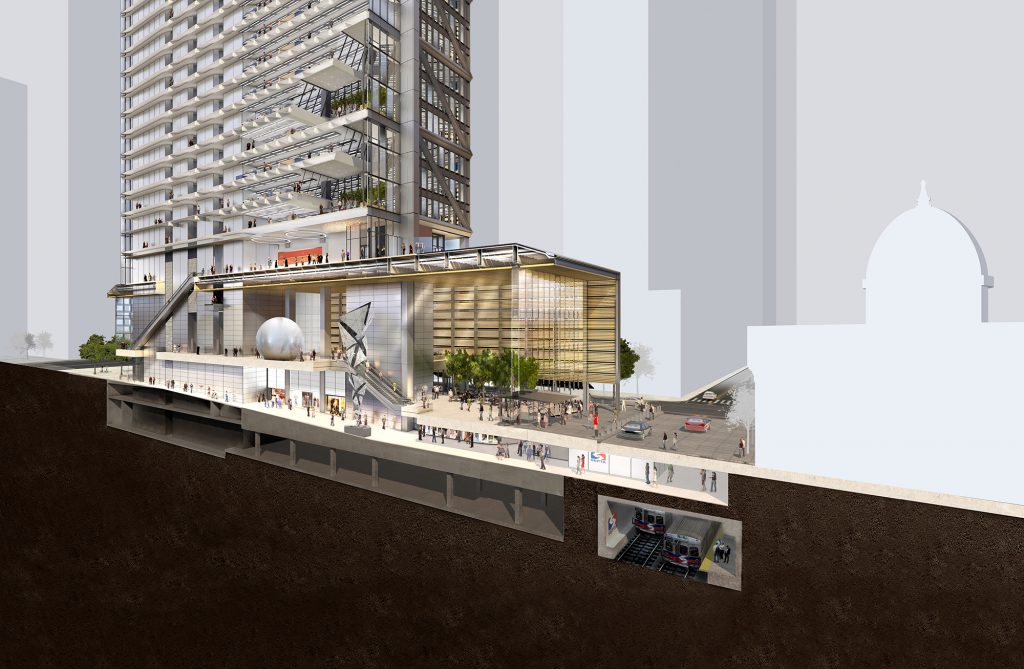
In the heart of Philadelphia sits the new Comcast Technology Center. The 60-floor, 1,121-foot skyscraper is the tallest building in Philadelphia and the Commonwealth of Pennsylvania, the tenth-tallest building in the United States, and the tallest outside Manhattan and Chicago.
The building is adjacent to Comcast’s corporate headquarters and the roughly 1.9 million square feet of building supports a large employee base, with many depending on the Southeastern Pennsylvania Transportation Authority (SEPTA) commuter rail system for their daily commute. The SEPTA concourse system, specifically Suburban Station, is a gateway for commuters to enter Center City and provides access to approximately 25,000 passengers daily. To help alleviate pedestrian congestion on 18th Street, which separates the new tower from the original Headquarters Tower building, and extend the station concourse through the new building to 19th Street, the developers constructed a pedestrian tunnel crossing under 18th Street to a public concourse under the new building. This addition to the station complex extends the concourse to 19th Street.
The installation of the pedestrian tunnel was no easy feat, and almost seemed impossible to achieve. In order to clear the way for the new tunnel, significant public utilities had to be rerouted including major electrical, teledata, steam, water, gas, and sewer infrastructure of which the sewer and water were designed by Pennoni.
 In addition to the utilities, understanding the existing SEPTA infrastructure related to the underground rail system was equally important. For a portion of its 100-ft length, the pedestrian tunnel is resting on top of the 80‐year‐old train tunnel structures. Our extensive site investigations for the tunnel construction included archive records research, test pit excavations, ground penetrating radar, 3-D survey scans from the surface and in the SEPTA tunnels, and coordination with numerous agencies. Installation of the tunnel across 18th Street required raising the grade of the street almost 3-ft, necessitating a redesign of the entire block.
In addition to the utilities, understanding the existing SEPTA infrastructure related to the underground rail system was equally important. For a portion of its 100-ft length, the pedestrian tunnel is resting on top of the 80‐year‐old train tunnel structures. Our extensive site investigations for the tunnel construction included archive records research, test pit excavations, ground penetrating radar, 3-D survey scans from the surface and in the SEPTA tunnels, and coordination with numerous agencies. Installation of the tunnel across 18th Street required raising the grade of the street almost 3-ft, necessitating a redesign of the entire block.
“Finding a path to join those two buildings was one of the most challenging parts of the entire project,” recalls John Gattuso, President and CEO of Gattuso Development Partners. “We had to go across 18th Street, over the top of the rail tunnel, adjacent to and through all the utilities, and underneath the ramp in the parking garage. We literally had to raise the entire height of the street by two feet, relocate vast amounts of massive utilities and find a way to squeeze the concourse through any number of foundations, including the foundation of the church.”
Pennoni had primary responsibility for preparing conceptual options and preliminary designs, and coordination with all affected utility owners and City agencies. Once the tunnel corridor was confirmed and utility owners had signed-off on the proposed tunnel routing/utilities rerouting, a preliminary design was coordinated with the tunnel design team including Kelly/Maiello Architects and Thornton Tomasetti structural engineers. Pennoni continued to provide design review and coordination between various utilities owners, particularly the Philadelphia Water Department and the tunnel design team and constructors as they finalized their utility relocation design and carried out construction.
Image by Foster + Partners
Tom Friese serves as Associate Vice President and Division Manager in our Site/Civil Design and Landscape Architecture Division with more than 36 years of site design experience.
For more information on this project, contact Tom at TFriese@Pennoni.com.
